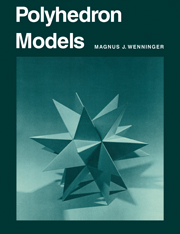Book contents
- Frontmatter
- Dedication
- Contents
- Preface to 1978 reprint
- Preface
- Foreword
- Introduction: uniform polyhedra
- Mathematical classification
- Section I The Convex Uniform Polyhedra: The Platonic and Archimedean Solids
- Section II Some Stellations and Compounds
- Commentary on stellations and compounds of the Platonic solids
- The stellated octahedron (19)
- Stellations of the dodecahedron (20–22)
- Commentary on the stellated icosahedron
- Stellations of the icosahedron (23–42)
- Commentary on the stellation of the Archimedean solids
- Stellations of the cuboctahedron (43–46)
- Commentary on the icosidodecahedron
- Stellations of the icosidodecahedron (47–66)
- Section III Non-convex Uniform Polyhedra
- Epilogue
- References
- List of models
Commentary on the stellation of the Archimedean solids
from Section II - Some Stellations and Compounds
Published online by Cambridge University Press: 05 August 2015
- Frontmatter
- Dedication
- Contents
- Preface to 1978 reprint
- Preface
- Foreword
- Introduction: uniform polyhedra
- Mathematical classification
- Section I The Convex Uniform Polyhedra: The Platonic and Archimedean Solids
- Section II Some Stellations and Compounds
- Commentary on stellations and compounds of the Platonic solids
- The stellated octahedron (19)
- Stellations of the dodecahedron (20–22)
- Commentary on the stellated icosahedron
- Stellations of the icosahedron (23–42)
- Commentary on the stellation of the Archimedean solids
- Stellations of the cuboctahedron (43–46)
- Commentary on the icosidodecahedron
- Stellations of the icosidodecahedron (47–66)
- Section III Non-convex Uniform Polyhedra
- Epilogue
- References
- List of models
Summary
In the previous pages you saw the stellation process applied to the Platonic solids. You may now be wondering whether the Archimedean solids can also be stellated. The answer is that they can. The procedure is the same: each facial plane must be extended indefinitely to generate cells exterior to the original solid. Using these cells as building blocks, you can form many new solids, theoretically at least. In practice however, for the purpose of making models, the stellation pattern is more useful, although you will find it helpful to have some acquaintance with the cells as well. Nets for these cells can easily be found from the stellation pattern. But you may be asking yourself: why should anyone want to stellate the Archimedean solids? Isn't it a lot of work? Yes, the work involved here does begin to look overwhelming. It really calls for team work. It is hard to find much published material on this topic, and undoubtedly it is because of the great number of possible forms that come crowding up for consideration. A complete enumeration of all the possible stellations is a mathematical question that has yet to be investigated. No doubt some restrictive rules, such as J. C. P. Miller designed for the case of the icosahedron, would have to be applied here also. These forms do not always turn out to be particularly attractive or aesthetically pleasing, but then again many of them do. The final stellation usually seems to be of more than ordinary interest.
A more important question mathematically is: Are any of these stellated Archimedeans regular or uniform polyhedra? Before attempting any answer to this problem, you will find it enlightening to see the stellation process applied to at least two Archimedeans.
The cuboctahedron and the icosidodecahedron are given here because of their close relationship to the dual Platonic pairs.
- Type
- Chapter
- Information
- Polyhedron Models , pp. 66 - 67Publisher: Cambridge University PressPrint publication year: 1971



